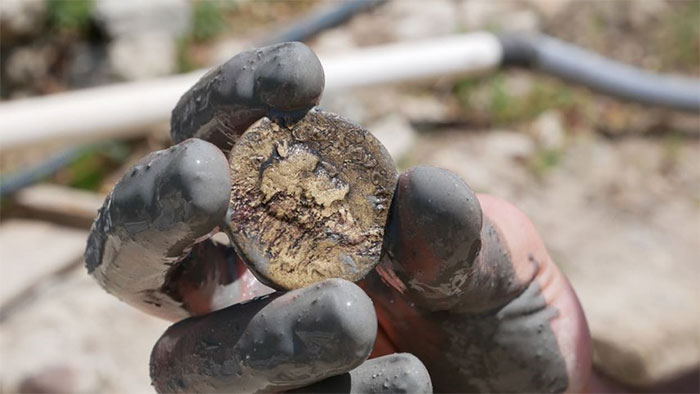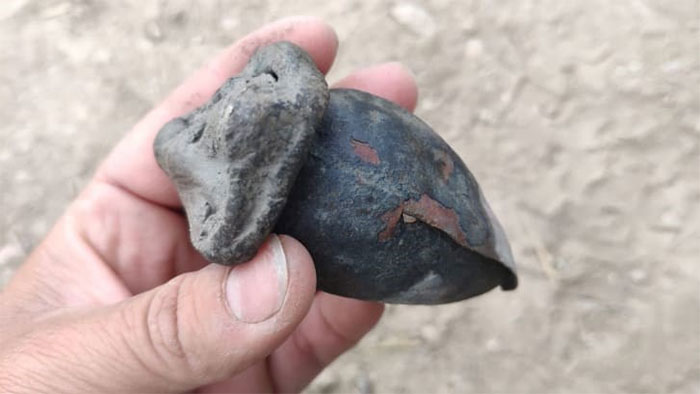Ancient 'birth statues' under famous Tuscan hot springs
The Tuscan thermal baths are a network of holy pools built by the pre-Italian Etruscans in the early 4th century BC, and later transformed by the ancient Romans into more luxury. , in the midst of an era where health and faith are deeply intertwined.
San Casciano is a geothermal center with 40 hot springs, 6 of which are connected to the thermal reserve. The Etruscans chose this location to use the therapeutic power of the water's chemical properties - which are rich in minerals such as calcium and magnesium, as well as chlorides and sulfates.

Archaeological remains were found beneath the Tuscan hot springs.
Archaeological discovery
Last week, archaeologists at the site unearthed a treasure trove of artifacts and relics, shedding light on the intimate connection that past civilizations had between Italy and the "religion of water," or The divine healing origin of hot spring water.
Rare items said to be used as offerings to the gods - including so-called "fertility idols" dug up from the area's mud. Add to that 3,000 antique coins, 700 of which are newly minted - and still shiny.
In the second century AD, Roman Emperor Marcus Aurelius Carus threw coins into the bathtub in honor of the gods who looked after his health, as well as that of all the Romans who came to San Casciano for treatment. heat treatment.

Rare items are said to be used as offerings to the gods.
Archaeologist Jacopo Tabolli, Scientific Director of the excavation project said: "What makes this site unique in the entire Mediterranean is its exceptional conservation status, and the evidence that it is here. provides about how hot water is considered a healer under divine protection".
"The quantity and quality of the items unearthed is also astounding - we knew there was something underground but we didn't expect it to be so unexpected," he stressed.
The excavation site now includes an Etruscan pool, 11 m long and 5 m deep known as the "big bath", and five smaller Roman pools, where hot water still flows in at a rate of about 2,000 gallons per minute. .
There are ruins of fountains and statues along with travertine stone altars to the god of prophecy and medicine, Apollo, the goddess of fertility, Isis, and the goddess of the first birth, Fortuna Primigenia.

The quantity and quality of the unearthed objects is also astounding.
"Sacred Mountain"
San Casciano locals have long called the site a "sacred mountain," Tabolli said, citing a 16th-century doctor's report mentioning the presence of buildings. antique and a fountain.
A geophysical survey conducted by Tabolli's team in 2019 revealed the presence of structures on the springs. The following year, ancient columns were discovered protruding from a bush and excavation work began.
San Casciano's ancient natural hot tubs function like a clinic, where travelers seek respite from respiratory problems or bone aches.
For many people, a dip in the water relieves their pain, so after bathing, they throw offerings to the gods into bubbling pools to give thanks for being healed. These include twigs, fragrant pine cones and fruits such as peaches - which have been restored to a well-preserved state by the mud layers that the area has covered.

Some of the relics are sculpted in the form of miniature bronze legs, hands and ears.
A number of relics sculpted in the form of miniature bronze feet, hands and ears as offerings have also been unearthed. They were left to thank the gods for healing specific parts of the body, or to call attention to mortal prayers during pain.
Wellness rituals performed in hot tubs include those specifically related to pregnancy and childbirth.
A restored nude baby statue leads archaeologists to believe that ancient women would visit San Casciano both during their pregnancy and after giving birth in the hope of protecting the health of the babies.
According to Tabolli, a number of coins of copper, silver and orichalcum - a precious metal believed by the Romans to have mystical powers - were found in the large bath. This is the largest collection of ancient coins associated with hot springs in the Mediterranean, and is also unique in their perfect state of preservation. The coins retain their original color thanks to the chemistry of the water and by being covered with mud, which prevents oxidation.
"They are still shiny brown and shiny yellow - such bright colors have never been found in any excavation site," said Tabolli. "It's a miracle." .
- Detecting ancient phenomenon on the seabed of Cu Lao Cham
- Decipher the unusual statues of the year 1,400 years
- The truth behind many ancient Egyptian statues lost their noses
- Top 10 world famous Buddha statues
- Why are ancient Greek statues naked?
- Egypt announced two giant pharaohs
- The mysterious magnetic field covered 10 ancient statues 2,000 years
- Discovered more than 3,000 years of pharaoh statues
- Find the ancient Roman statue at the underwater palace
- The interesting story behind the childhood toy
- Discover 19 mysterious ancient statues in the clay city
- Techniques to help the ancient people put stone caps 13 tons on top of the statue
 Discovered an ancient centipede fossil 99 million years old
Discovered an ancient centipede fossil 99 million years old Discovered bat-like dinosaurs in China
Discovered bat-like dinosaurs in China Discovered a 200-year-old bronze cannon of the coast
Discovered a 200-year-old bronze cannon of the coast Discover 305 million-year-old spider fossils
Discover 305 million-year-old spider fossils